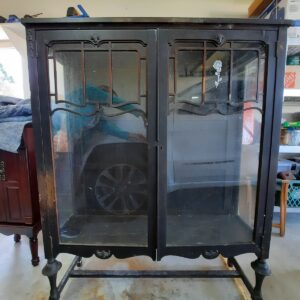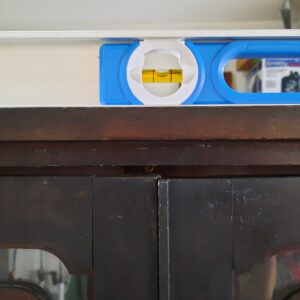Advice for Leveling Doors on Antique China Cabinet
I am trying to eliminate the center sag in the doors of this antique china cabinet.
So far, I have leveled the cabinet, glued/tightened the lower legs and stretcher. The box was/is a little wobbly and out of square, so I have squared it up (at least temporarily) with two diagonal turnbuckles across the back. At least now the two doors are sagging somewhat evenly (1/4″ on the left and 5/16 on the right) – I’ll count this as progress!
The doors have large glass and are heavy; the hinges are butt hinges with ball tips, but I have not tried to take the pins out. The doors do not seem to wobble on the hinges and the hinges appear to be solidly attached to the frame.
It seems I would need to add more space between the bottom hinges and the frame in order to drive the middles of the doors upward. Shim, I suppose? But it also seems that is likely to make the doors bind, since right now the vertical spacings between each of the doors and between the doors and the frame are consistently small. I sure don’t want to cut or sand on the doors and create more problems.
Any advice on how to proceed?

















Replies
I know you squared the back and I wonder if that transferred to the front. Having glass sides, I don’t see where the leverage is for the front.
Thanks user-76961, I wondered this too. At this time I do not have anything separately influencing the front of the case, but all sides are showing level/plumb so it appears the tightening affects the whole case.
Put a known straightedge all the way across the top and bottom of the case to check them both for flat. The whole case may have sagged to center over time under the weight of the doors. I think the "fix" will be thin cardboard shims behind the lower hinges. Think cereal box cardboard...non-compressable.
If you turn it upside down for a hundred years it will probably correct itself!
Wow that is one racky looking piece, but very nice.
First thing I would try is loosen up the turnbuckles and see if you can pull the case to match the doors. You may have caused the issue doing that.
Other than that, you can try shimming the bottom hinge.
Or, live with it - its an antique!!
Thanks RobertEJr,
The turnbuckles appear to have evenly distributed the existing gap between the two doors. as it was about 1/2" on the left door only, and is now about 1/4" on each door.
I had a very similar problem recently; an old china cabinet that was not square and the doors would not close properly. The basic problem begins with the design of the cabinet. Because it is designed for display, the frame is intentionally slim and, therefore, the joinery and slender frame does not have enough rigidity to resist all of the torsional forces. When you add the weight of the glass and the china, it just makes matters worse.
As was in my case, I would guess that all or most of the joinery in your cabinet is loose and the whole unit is not rigid enough to stay square. Unfortunately, the only proper answer is to disassemble it and re-glue all of the joints and get all components squared up. Even after that, I found that my cabinet would not remain square as there was just too much flex in the thin frame members.
I would love to know what antique restoration folks or other experts think about this. I determined that I needed to treat the glass held in the frame as structural components. So, rather than installing the glass with typical quarter round nailed in place, I caulked it in place as you would an exterior pane in your house before adding the quarter round. This added considerable rigidity to the structure and now the doors close and swing properly even when the cabinet is loaded with china.
I hope this helps.
Thanks bilyo,
Yes, the design seems high on looks but short on structural support. The side glasses seems very well and snugly installed. However, the heavy glass doors do not rest on any base, even when closed, so the hinges and side frame take all the stress of their weight. When the joints near the back righthand water-damaged leg became loose it seemed to cause the diagonal (top left) to also come out of square creating the original gap at the top of the left door.
Now that it is squared up, I am thinking of options to help keep it that way. I am leaning (no pun intended) towards a thin backer-board attached all around the edges of the squared frame.
Thanks _MJ_,
Lol, I'm ready to turn it upside down!
All sides of the case appear flat and level/plumb. Prior to the turnbuckles all of the sag was all on the left side (almost a half inch), now a smaller gap is showing on both doors.
If I get brave enough to shim the hinges I was planning on using some thin veneer
If the gap between the door and the case sides is equal all along the length, swimming hinges may bring the top and bottom into line, but now the side gaps will be uneven, and jump right out at you. You'd be trading one problem for another.
With something really old, whether it's furniture or a door in a house, I don't sweat squareness that much. Trying to make things square is just not usually possible. And often, our eyes are used to it, and don't care.
What our eyes do tell us as being really wrong is an uneven gap. You obviously see this issue at the top of your doors. My only focus would be finding a way to make that gap even all around. As long as the case is not wobbly, it doesn't matter nearly as much if it's square.
Thanks John_C2,
Yes, I agree. The imperfections just get moved around by squaring and shimming. So far the ~1/4" gaps on each door is better than 1/2" gap on only one door. I guess I'll get brave (I'm a little intimidated to work on hinges) and try to shim a little so that the sides can take some of the remaining gap away from the top. Once things are optimally positioned, I plan to glue any remaining loose joints and maybe put a backerboard on for stability.
It is when the doors are closed that you want to achieve evenness .I had a similar cabinet where the previous owner let in a brass shoe under each point where the door closed .Each shoe raised each door the proper amount to make parallel the seam and each hinge side.The bottom was not perfect but the shims took the "rack" out of each door.Obviously the doors sagged due to the weight of the glass and the flimsy door frame.
Thanks paulsshop,
Yes, I'm thinking something like this will be good to support the center of the doors. Is the "brass shoe" you refer to something sold specifically for this purpose?
Opinion; the glass is the problem. I'd disassemble the doors & rebuild the frame around the glass, not frame first. And move the hinges more toward the center an inch or two.
Mikaol
Thanks Mikaol,
I can see how the weight of the glass is a contributing problem, but you seem to be implying something else. Can you elaborate?
I haven't seen anyone ask you if the doors themselves are square. They may have sagged over time, even if the joints don't appear to be broken. If so, the only fix would be to remove the glass, flex the frames square, and replace the glass as a structural component as Bilyo suggested.
If you want to shim the hinges, it's pretty easy. Just loosen the screws of a bottom hinge, and slide a piece of cardboard (cereal box type) in, then tighten the screws. This is more effective than removing the whole hinge, and easier. Make the cardboard piece a bit shorter than the height of the hinge, and narrow enough to hide between the front of the door and the nearest screws. You can do it to both the door side and the frame side in situations where you need to shim a lot, as it is less visible than all in one place.
There is another option in situations where there is a lot of space between the leaves of the upper hinge. You can move the pivot point of the hinge away from the middle of the cabinet and toward the corner by putting a shim under just the back edge of the upper hinge ON THE FRAME SIDE ONLY. Too much here and the door will be hinge-bound,which means the leaves will hit when you try to close the door. The amount of effect will vary depending on how far out from the front of the cabinet the hinge knuckle is.
The nice thing about shimming the hinges is that you can always decide you like it better the way it was (or partway to the spot you are now) and put it back like it was. Just last Saturday I was working on a large (8'x44") commercial door, trying to get it to not drag, and I put enough cardboard layers in that the door scraped the jamb. So I removed one layer.
Good luck!
Harvey Baker
This forum post is now archived. Commenting has been disabled